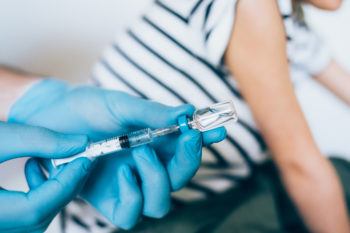Study Shows Sharp Decrease In Texas Childhood Vaccination Rates During Pandemic

Despite expert recommendations that children continue to get regularly scheduled vaccines during the pandemic, vaccination rates have decreased in several states.
A new study by researchers from the Texas A&M University School of Public Health and several other research institutions looked at childhood immunization rates in Texas to see what effect the COVID-19 pandemic may have had on childhood immunizations in 2020. In the study, led by public health doctoral student Tasmiah Nuzhath and published in the journal Vaccine, the researchers used data from a statewide immunization registry to determine how immunization rates changed over a 10-year period for children at four age milestones: one month, five months, 16 months and 24 months. The researchers also analyzed county-level data from 2019 and 2020 to compare rural and urban locations.
To see how much effect the pandemic had on vaccination rates in Texas, the research team analyzed data from the ImmTrac2 immunization registry from May 2010 through May 2020. The data was provided by the staff at Texas Department of State Health Services (DSHS) and included immunization records for more than 300,000 Texas children from birth to 24 months. Their analysis found that the proportion of children who were current on recommended vaccines in the four age categories increased between 2010 and 2019. However, there were sharp decreases in vaccination between 2019 and 2020 in most categories, which the authors attributed to the COVID-19 pandemic.
The decline in vaccinations the researchers found was similar to those found in other states. The declines were greatest for the 5-month-old and 16-month-old groups. The age groups saw 47 percent and 58 percent declines, respectively.
Their analysis of county-level data found that 5-month-old children in rural locations had greater declines in immunization rates than those living in urban areas. They also found that there was no decrease in Hepatitis B vaccines at birth. This points to immunizations that take place in clinics or doctor’s offices as opposed to hospitals being the most affected by the pandemic.
Researchers also found that uptake of most vaccines appeared to increase prior to the pandemic between May 2010 and May 2019, with the exception of measles vaccine. MMR (measles, mumps and rubella) coverage has been declining in Texas since 2015, and is currently below the 95 percent coverage level required to achieve herd immunity. The already low level of measles vaccination coverage, exacerbated by the pandemic, increases the risk of a measles outbreak in Texas and could have substantial public health consequences.
The findings of this study are in line with those focusing on other states, but the researchers note that the findings are limited by their data source. ImmTrac2 is an opt-in registry, which means that the data may not reflect the population as a whole. However, despite this limitation, the findings point to possible disruptions in vaccination services as well as disparities between rural and urban communities. These results indicate that there is a need for better targeted public health communication to address perceived risks and for improved vaccination infrastructure to help overcome barriers to vaccination in rural areas.
Additional researchers from the School of Public Health include Qiping Fan, Brian Colwell and Timothy Callaghan; Kobi Ajayi from the Texas A&M Department of Health and Kinesiology; Dr. Peter Hotez from the Texas Children’s Hospital Center for Vaccine Development and Baylor College of Medicine; and Annette Regan from the University of San Francisco School of Nursing and Health Professions and the UCLA Fielding School of Public Health.
This article by Rae Lynn Mitchell originally appeared on Vital Record.





